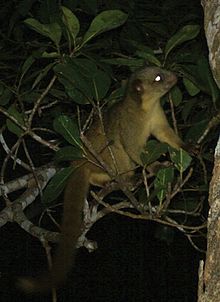Eastern lowland olingo
This is an old revision of this page, as edited by DenesFeri (talk | contribs) at 09:14, 19 May 2020. The present address (URL) is a permanent link to this revision, which may differ significantly from the current revision.
| Eastern lowland olingo | |
|---|---|

| |
| César M. Aguilar Photo, ZooKeys. Yambrasbamba, Bongará, Amazonas, Peru. | |
| Scientific classification | |
| Domain: | Eukaryota |
| Kingdom: | Animalia |
| Phylum: | Chordata |
| Class: | Mammalia |
| Order: | Carnivora |
| Family: | Procyonidae |
| Genus: | Bassaricyon |
| Species: | B. alleni
|
| Binomial name | |
| Bassaricyon alleni Thomas, 1880
| |

| |
| Black points mark the range of B. alleni[2] | |
| Synonyms | |
|
Bassaricyon beddardi Pocock, 1921 | |
The eastern lowland olingo (Bassaricyon alleni) is a species of olingo from South America, where it is known from the lowlands east of the Andes in Bolivia, Brazil, Colombia, Ecuador, Guyana, Peru and Venezuela.[1][3] It is the only olingo species found east of the Andes.[2] The Latin species name honors Joel Asaph Allen, the American zoologist who first described the genus Bassaricyon.[4]
Description
The eastern lowland olingo is smaller than the northern olingo, but larger than the recently described olinguito ("little olingo"), the most montane member of the genus.[2] It is larger than the western lowland olingo subspecies B. medius medius from west of the Andes, but about the same size as the B. m. orinomus subspecies from eastern Panama.[2] The pelage is slightly darker than the western species.[2]
It has a head-body length of 30 to 45 centimetres (12 to 18 in), with a tail length of 40 to 53 centimetres (16 to 21 in).[2] It weighs 1.1 to 1.5 kilograms (2.4 to 3.3 lb).[2]
Taxonomy
The closest relative of the eastern lowland olingo is the western lowland species, B. medius, from which it diverged about 1.3 million years ago.[2]
Notes
- ^ a b Helgen, K.; Kays, R.; Pinto, C.; Schipper, J. (2016). "Bassaricyon alleni". IUCN Red List of Threatened Species. 2016. IUCN: e.T48637566A45215534. doi:10.2305/IUCN.UK.2016-1.RLTS.T48637566A45215534.en. Retrieved 10 March 2019.
- ^ a b c d e f g h Helgen, K. M.; Pinto, M.; Kays, R.; Helgen, L.; Tsuchiya, M.; Quinn, A.; Wilson, D.; Maldonado, J. (2013-08-15). "Taxonomic revision of the olingos (Bassaricyon), with description of a new species, the Olinguito". ZooKeys. 324: 1–83. doi:10.3897/zookeys.324.5827. PMC 3760134. PMID 24003317.
{{cite journal}}: CS1 maint: unflagged free DOI (link) - ^ Bassaricyon alleni - Allen's Olingo NatureServe.org
- ^ Beolens, B.; Watkins, M.; Grayson, M. (2009-09-28). The Eponym Dictionary of Mammals. The Johns Hopkins University Press. p. 8. ISBN 978-0801893049. OCLC 270129903.
Extant Carnivora species | |||||||||||||||||||||||||||||||||||||||||||||||||||||||||||||||||||
|---|---|---|---|---|---|---|---|---|---|---|---|---|---|---|---|---|---|---|---|---|---|---|---|---|---|---|---|---|---|---|---|---|---|---|---|---|---|---|---|---|---|---|---|---|---|---|---|---|---|---|---|---|---|---|---|---|---|---|---|---|---|---|---|---|---|---|---|
| |||||||||||||||||||||||||||||||||||||||||||||||||||||||||||||||||||
| |||||||||||||||||||||||||||||||||||||||||||||||||||||||||||||||||||
| |||||||||||||||||||||||||||||||||||||||||||||||||||||||||||||||||||
| |||||||||||||||||||||||||||||||||||||||||||||||||||||||||||||||||||
| |||||||||||||||||||||||||||||||||||||||||||||||||||||||||||||||||||
| |||||||||||||||||||||||||||||||||||||||||||||||||||||||||||||||||||
| |||||||||||||||||||||||||||||||||||||||||||||||||||||||||||||||||||
| |||||||||||||||||||||||||||||||||||||||||||||||||||||||||||||||||||
| Bassaricyon alleni | |
|---|---|
This article about a carnivoran is a stub. You can help Wikipedia by expanding it. |

